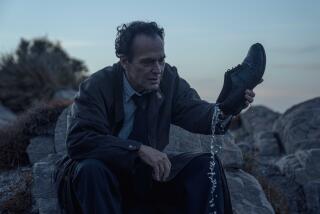The astonishing Jean Cocteau
Jean Cocteau has received a bit more ink than usual this year thanks to the No. 1 bestseller “The Da Vinci Code,” in which novelist Dan Brown asserts that the famed avant-garde French artist was a member, along with Leonardo Da Vinci, Isaac Newton and Victor Hugo, of a secret society called the Priory of Scion.
But this new notoriety is not the reason the Los Angeles County Museum of Art’s film department is devoting the next three weekends to Cocteau’s magical cinema.
“I had been thinking about French films because of the French exhibitions [‘French Masterworks From the Pushkin Museum, Moscow’] we were doing this summer,” says film department head Ian Birnie. “I knew there was a new print of ‘Beauty and the Beast’ and I thought it was great to look at Cocteau again.”
Although two of Cocteau’s films, the 1946 classic “Beauty and the Beast” and 1949’s “Orpheus,” have long been shown stateside at festivals and revival theaters and are available on videocassette and DVD, the majority of the other films in “Astonish Me! Jean Cocteau and the Cinema,” are rarely seen in America.
“There are no prints in America -- only in Europe,” explains Birnie, who secured several prints for the festival from the French Ministry of External Affairs.
The festival, which begins Saturday and continues through Oct. 4, features such rarities as 1943’s “Le Baron Fantome,” 1950’s “Les Enfants Terribles,” 1945’s “Les Dames Du Bois de Boulogne,” 1948’s “Les Parents Terribles” and 1947’s “The Eagle Has Two Heads.” Cocteau didn’t direct all the films in the festival; in the cases of “Enfants,” “Les Dames” and “Fantome,” he either wrote the screenplay or the dialogue.
Cocteau, who was born in 1889 and died in 1963, was a genuine renaissance man -- an artist, a poet, a playwright, a novelist, a director and a designer. From 1914 until he made his first film in 1931, Cocteau was one of the best-known celebrities in France. He collaborated with Stravinsky and Picasso, both of whom he described as influences on his career, on the Diaghilev ballet “Parade”; founded the satirical journal Le Mote; staged his plays of “Orpheus” and “La Voix Humaine”; wrote the novel of “Les Enfants Terribles” while kicking his drug habit; and published a memoir, “Opium.”
His movies were very influential on French New Wave directors such as Francois Truffaut; it’s no coincidence that Jean-Pierre Leaud, the young star of Truffaut’s first film, “The 400 Blows,” makes a cameo in Cocteau’s swan song, 1960’s “The Testament of Orpheus.”
“He was also very influential on the American avant-garde,” says Birnie. And his films “were the most personal cinema, I think, imaginable. He basically started as a writer. He always called himself a writer. Even when he was making films, he talked about writing with film or making poetry with film. He once said if you are not telling a conventional story then the image itself has to tell a story. After we see so many conventional boy-meets-girl movies, it’s just interesting to see somebody who is going to make a movie from another perspective. What is important is not the story per se, but the poetic ideas or the way the images are put together. Like in the film ‘Les Parents Terribles,’ there are a huge number of very large close-ups. It becomes kind of a signature style of the movie.”
His main male characters were, more often than not, like himself -- poet figures. “Whether it is Orpheus or the Beast,” says Birnie, “these people are forced to quest and find some kind of redemption.... I think all the things that obsessed Cocteau all of his life are visible in all of the things he did, whether it was painting, drawings, books, poetry or stage crafts.”
The films he directed -- even the muddled “Testament of Orpheus” -- are visually astonishing, especially his 1931 experimental film “Blood of a Poet” and “Beauty and the Beast” and “Orpheus.” Decades before computerized special effects, Cocteau used mirrors and reverse projection to create magical effects and fanciful but often dangerous worlds.
Cocteau admitted when he made “Blood of a Poet” that he “knew absolutely nothing about the art of movies.”
When he directed his first narrative film, “Beauty and the Beast,” Cocteau didn’t know how to do a tracking shot. Instead of putting rails down in order to move the camera, he put actress Josette Day, who played Beauty, on a cart and dragged it down the hall.
“So it wasn’t the camera that was moving, it was the actor,” says Birnie. “But it worked. He said his films are full of mistakes, but the mistakes are where you find the truth. I believe that. I think that things that are handmade have a certain type of authenticity.”
Like many artists who come from the theater, says Birnie, Cocteau worked with “very simple means to create extravagant effects.”
*
‘Astonish Me! Jean Cocteau and the Cinema’
*
Where: Leo S. Bing Theater,
Los Angeles County Museum of Art, 5905 Wilshire Blvd., L.A.
When: 7:30 p.m.
Saturday: “Beauty and the Beast” and “Le Baron Fantome”
Sept. 26: “Les Enfants Terribles” (also at 9:30 p.m.)
Sept. 27: “Les Dames du Bois de Boulogne,” “Les Parents Terribles”
Oct. 3: “Orpheus” and “The Eagle Has Two Heads”
Oct. 4: “Blood of a Poet,” “Testament of Orpheus”
Ends: Oct. 4
Price: $6-$8
Contact: (323) 857-6010 or www.lacma.org
More to Read
Only good movies
Get the Indie Focus newsletter, Mark Olsen's weekly guide to the world of cinema.
You may occasionally receive promotional content from the Los Angeles Times.










